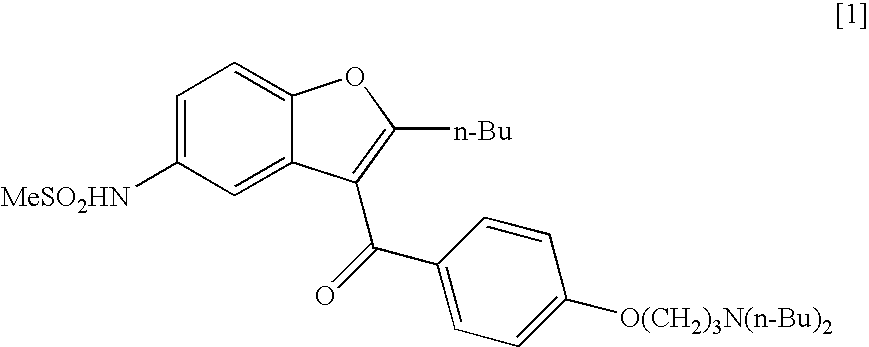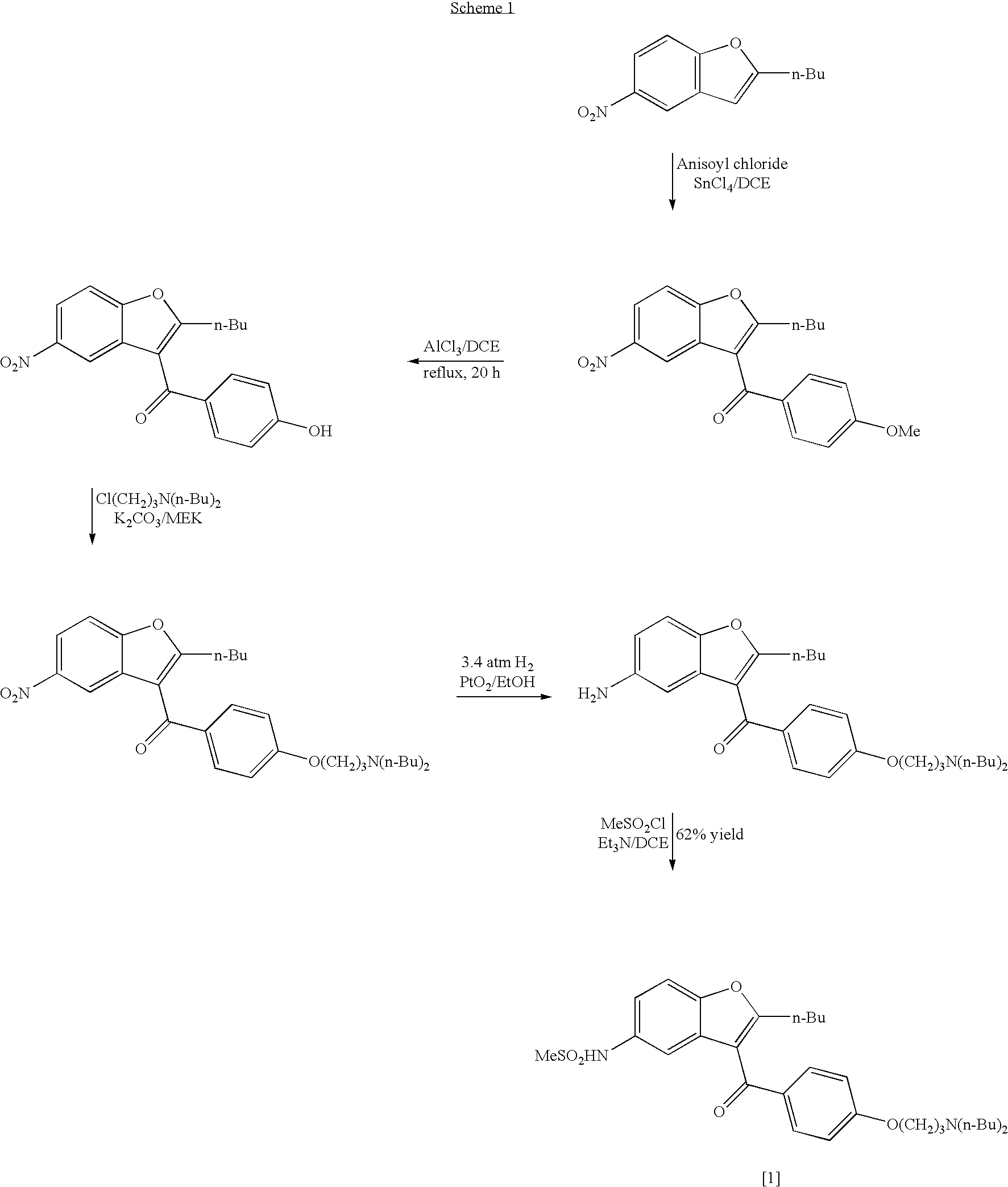Process for the preparation of dronedarone
a technology of dronedarone and process, which is applied in the field of process for the preparation of dronedarone, can solve the problems of increased cost, unstable compound of 2-butyl-5-benzofuranamine free base, and inability to store for long periods of time, and achieves the effect of low cost and high overall yield of produ
- Summary
- Abstract
- Description
- Claims
- Application Information
AI Technical Summary
Benefits of technology
Problems solved by technology
Method used
Image
Examples
example 1
[0061]
[0062]Acetic anhydride (10.21 g, 9.4 mL, 100 mmol) was added dropwise over 1 hour to a stirred solution of p-anisidine (12.32 g, 100 mmol) in dichloromethane (40 mL) at 25-30° C. The mixture was stirred for an additional 1 hour at the same temperature. Hexane (120 mL) was added dropwise to the mixture at 25-30° C. The obtained suspension was stirred for 1 hour at the same temperature. The precipitated crystals were separated by filtration and dried under reduced pressure to give 15.31 g (92.7%) of N-(4-methoxyphenyl)acetamide [3a] as off-white crystals.
[0063]1H NMR (CDCl3): 7.84 (bs, 1H), 7.35 (m, 2H), 6.79 (m, 2H), 3.74 (s, 3H), 2.08 (s, 3H).
example 2
[0064]
Aluminium chloride (20.00 g, 150 mmol) was carefully added to a stirred solution of N-(4-methoxyphenyl)acetamide [3a] (8.26 g, 50.0 mmol) in dichloromethane (30 mL) at 0-5° C. (ice / water bath). Nitromethane (8.2 mL, 150 mmol) was added to the mixture in one portion. A solution of 2-bromohexanoyl chloride (12.81 g, 60.0 mmol) in dichloromethane (20 mL) was added dropwise to the stirred mixture at room temperature. The obtained mixture was stirred for 4 hours at the same temperature. Aluminum chloride (6.67 g, 50.0 mmol) was added in one portion to the stirred mixture at room temperature. The mixture was stirred overnight at the same temperature. The mixture was carefully poured into ice / water mixture. The mixture was extracted with ethyl acetate (150 mL then 2×50 mL). The combined organic layers were washed with brine (50 mL), dried over sodium sulfate, filtered and evaporated under reduced pressure at 50° C. (water bath). The residue (21.20 g) was stirred with hexane (150 mL) ...
example 3
[0066]
[0067]Sodium bicarbonate (3.36 g, 40.0 mmol) was added in several portions to a stirred boiling mixture of N-[3-(2-bromohexanoyl)-4-hydroxyphenyl]acetamide [6a] (13.13 g, 40.0 mmol) and methanol (30 mL). The mixture was stirred under reflux conditions for 2 hour. Sodium borohydride (1.51 g, 40.0 mmol) was added in several portions to the mixture at 0-5° C. (ice / water bath). The mixture was stirred for 30 min at the same temperature and 15% hydrochloric acid (100 mL) was added. The solution was stirred for 4 hours under reflux conditions and for 1 hour at 0-5° C. (ice / water bath). The precipitated crystals were filtered off, washed on the filter with water (20 mL) and ethyl acetate (20 mL) and dried to give 7.62 g (84.5% yield from 3 steps) of 2-butyl-5-benzofuranamine hydrochloride [12a] as off-white crystals with mp 190-193° C. (dec.).
[0068]1H NMR (CDCl3): 7.52 (s, 1H), 7.18 (s, 2H), 6.19 (s, 1H), 2.67 (t, J=7.2 Hz, 2H), 1.65 (m, 2H), 1.39 (m, 2H), 0.92 (t, J=7.2 Hz, 3H).
PUM
| Property | Measurement | Unit |
|---|---|---|
| temperature | aaaaa | aaaaa |
| volume | aaaaa | aaaaa |
| temperature | aaaaa | aaaaa |
Abstract
Description
Claims
Application Information
 Login to View More
Login to View More - R&D
- Intellectual Property
- Life Sciences
- Materials
- Tech Scout
- Unparalleled Data Quality
- Higher Quality Content
- 60% Fewer Hallucinations
Browse by: Latest US Patents, China's latest patents, Technical Efficacy Thesaurus, Application Domain, Technology Topic, Popular Technical Reports.
© 2025 PatSnap. All rights reserved.Legal|Privacy policy|Modern Slavery Act Transparency Statement|Sitemap|About US| Contact US: help@patsnap.com



